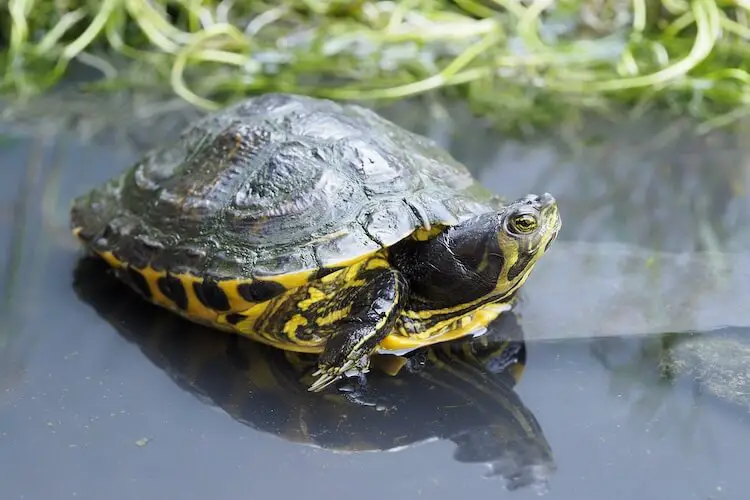
Yellow-bellied sliders are one of the most common species of turtle in the eastern United States. If you have ever seen turtles basking on a log near the east coast, there is a good chance you have already seen one!
These common turtles also make great pets. Their striking yellow and black colors, high activity levels, and unique aquatic lifestyle make them a standout pet.
However this unique lifestyle also makes them difficult for beginners to keep. They need a very large enclosure with lots of fresh water and eat a diet of mostly fresh vegetables.
If you are interested in owning on a slider then keep reading for tips on their care, diet, tank setup and more…
Species Introduction

Yellow-bellied sliders (Trachemys scripta scripta) are members of the Emydidae family. This family is home to over 50 different turtle species and includes terrapins and marsh turtles.
Originally named Testudo scripta in 1792 the species was renamed to Trachemys scripta scripta in 1857 by American biologist Louis Agassiz.
In the wild, yellow-bellied sliders are found in the southeastern United States near bodies of water like estuaries, lakes, marshes, and swamps. The name “slider” comes from their tendency to slide off logs and muddy banks into the water at the first sign of danger.
These turtles are a vibrant yellow and black with striped legs, neck, and head. The bottom part of their shell (i.e. plastron) is bright yellow with dark smudges or spots. The top is normally dark green or black.
Hatchlings are born about the size of a quarter and grow to be a foot in length after eight years. But, they continue to grow slowly for their entire lives and can end up weighing over seven pounds.
As they grow, sliders change their diet from primarily protein-based to a plant-based one. Pet species should eat mostly leafy green vegetables, supplemented with protein from insects. Pelleted turtle food is also a good choice.
Yellow-bellied sliders are a semi-aquatic turtle. This means they spend most of their time swimming, but sometimes they come on to land to bask and rest in the sun. To accommodate their lifestyle, their tank setup will need to be mostly water that is deep enough for them to fully submerge.
Are Yellow-Bellied Sliders Good Pets?
Yes, they make great pets and are charming, cute and active. Slider turtles became popular pets in the 1950s as hundreds of turtle hatchlings were sold throughout the United States.
Sliders are great pets for those who are not afraid of taking on a long-term commitment. Be prepared to go through a lot of fresh vegetables and do not expect to have a cuddly pet. These turtles are not a good choice for keepers who want to handle their pets. They become easily stressed if held and are known to carry salmonella.
Luckily, they are just as entertaining when left in their tank and are usually bold and inquisitive.
Sliders are entertaining reptiles with a lot of personality, perfect for an intermediate reptile keeper! They are very active during the day and are known to dive, swim, bask and dig.
Yellow-Bellied Slider Care
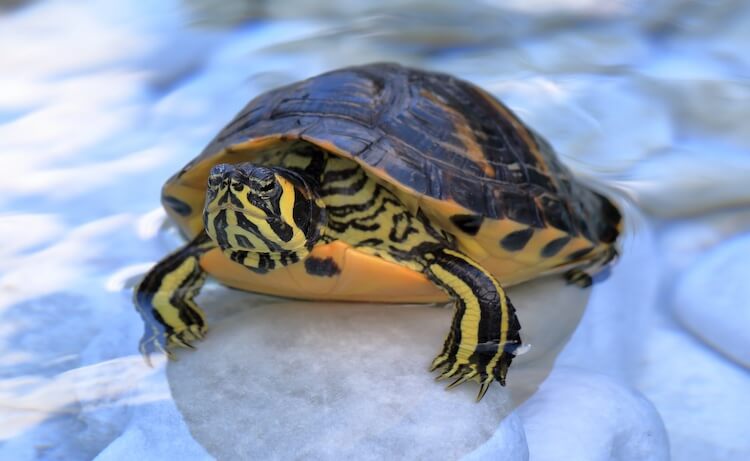
The trickiest part of caring for this turtle is keeping their enclosure clean. Unfortunately, many first time owners keep these pets in poor conditions which can cause outbreaks of salmonella. But, this should be no problem for intermediate and experienced herpetologists.
They make fantastic pets if given enough space and fed the right diet.
What Do Yellow-Bellied Slider Turtles Eat?
Yellow-bellied sliders are opportunistic feeders who eat whenever and whatever they can. This is not surprising given similar species, such as the snapping turtle, are also opportunistic feeders.
What is surprising is that their diet changes as they age.
Young turtles are primarily carnivores that feed on aquatic insects, worms, and small fish. As they grow into adults, their diet shifts to one that is made up almost entirely of plants!
Good Foods
- Carrot Tops
- Parsley
- Kale
- Turnip Greens
- Collard Greens
- Apples (As A Treat)
- Green Beans
- Water Lilies
- Red Bell Pepper
- Duckweed
- Waterweed (Elodea)
Bad Foods
- Iceberg Lettuce
- Feeder Fish
- Raw Meat
- Spinach
- Beets
- Rhubarb Greens
- Potato Greens
There are several high-quality aquatic turtle diets that are usually in the form of pellets. But, keep in mind that most of these diets are made for adult turtles rather than hatchlings. They can lack the protein needed by juveniles.
Baby turtles do best when fed small crickets, mealworms and cockroaches four times a week. You can also feed pieces of Romaine lettuce, dandelion greens and other vegetables, so that 1/3 of their diet is plant-based.
Growing turtles can be given two small meals every day. Gradually introduce more fruits and vegetables into your turtle’s diet, along with food pellets formulated for adults.
Fully grown turtles should be fed mostly pellets and leafy greens, along with some aquatic plants like duckweed.
Adults can also be fed crickets, shrimp, mealworms, and earthworms if you are not feeding pellets. Unlike juveniles, adults only need one meal every other day, with only 50% of their diet consisting of protein. To ensure proper nutrition, dust your turtle’s food with a multivitamin once each week.
Tank Setup
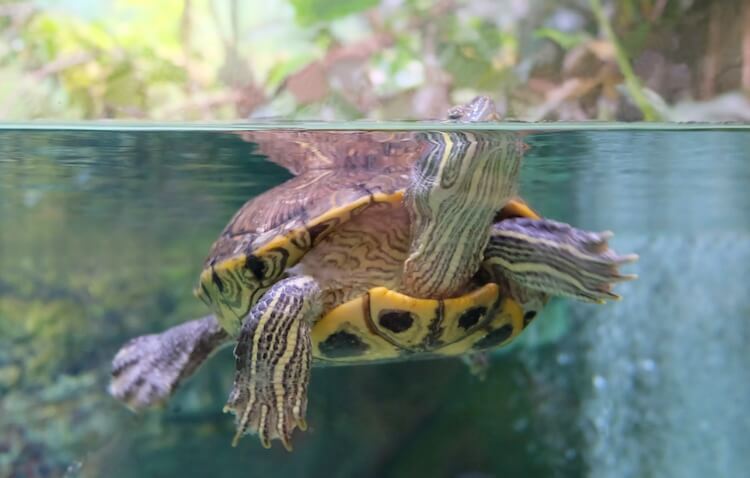
Yellow-bellied sliders are mostly aquatic and live in brackish and freshwater marshes, wetlands, lakes, and ponds in the southeastern United States.
Keeping sliders in a tank is relatively easy, provided you have the proper setup and equipment. They need a tank with water deep that is deep enough to submerge in with plenty of plants along the bottom.
Enclosure Size
When you first get a turtle hatchling you will need a 30-gallon tank. But, this should be changed for a larger tank after four years. Adult sliders need at least a 100-gallon enclosure to be healthy. Some owners use a standard glass fish tank to house their slider, while others use plastic pond liners to create a more natural setup.
Water
The tank water should be kept at 72 to 80°F with an underwater heater, and must be properly cleaned with a powerful aquarium filter. Sliders can thrive in freshwater, though brackish water can also be used. Brackish water for turtles can be a simple 50/50 mix of fresh and salt water (around 1.01 SG).
Water should be treated with a turtle-safe dechlorinator and be free from heavy metals and other pollutants. If you use brackish water, make sure to measure the salinity frequently, as the salt levels will increase as water evaporates.
Lighting and Heating
Turtles need to warm up before they can become active. Your Yellow-Bellied slider should have a basking spot on land that reaches 90 to 100°F, as well as a cooler area that is 72 to 76°F. Both UVA and UVB lights are essential for sliders metabolize calcium. A 5% UVB bulb, often marketed as a “tropical UVB” bulb, is ideal for sliders.
Substrate
Yellow-Bellied sliders need mostly water in their tank. In the water, the best substrate for sliders is no substrate or fine sand. Turtles can accidentally ingest gravel or pebbles, which can cause gastrointestinal impaction.
Some land should also be provided for basking. Adding a plastic or wooden platform to the side of the tank is important. It should be large enough for your slider to sit comfortably on.
Décor and Plants
Yellow-bellied sliders enjoy having plenty of hiding places. On land, live plants, flowerpots, plastic boxes, leaf litter and wooden logs are great décor options.
Live plants like waterweed, anubias, and mosses can be used in the water portion of your tank, but keep in mind that they may be munched on.
Health and Lifespan
Yellow-bellied sliders live for an incredibly long time. Many are able to live for 40 years! In the wild, their long lifespan is partly because of their tough shell, which prevents attacks from other animals.
Unfortunately, this protection comes with a downside. As their shell is their main line of defense, slider turtles put less energy into their immune systems. This makes them more vulnerable to bacterial diseases like mycoplasmosis and shell rot.
- Mycoplasmosis is a bacterial infection that causes respiratory irritation. Infected turtles have a runny discharge from the nose, bubbles around the mouth and audible breathing.
This disease is extremely infectious and passes from turtle to turtle through mucus. If you suspect your turtle may be infected, make sure to isolate and take it to a veterinarian.
- Shell rot is also a bacterial infection that affects turtles.
Also known as ulcerative shell disease or ‘rust,’ it is caused by bacteria from dirty water. Shell rot appears as gray, white, or red flaky or slimy spots on the top and bottom of the shell. If left untreated shell rot can cause open sores and secondary infections. The best way to prevent shell rot is to keep your turtle’s tank clean and monitor it for any injuries.
Regular cleaning and tank maintenance is the best way to keep your turtle healthy.
Signs They Are Healthy
- Even-colored shell with no abrasions.
- Strong, active swimming.
- Eating lots of food.
Sickness Symptoms
- Red and white patches on the shell.
- Floating at the top of the water, inability to dive.
- Closed or puffy eyes.
Appearance

Yellow-bellied sliders are beautiful turtles with black and yellow markings.
They are named after their yellow shell. The bottom and sides of their shell are a bright yellow with three to four black spots on each side. The top of their shell is a dark brownish green with orange and black wavy lines.
As they age, their shell often becomes darker in color, especially on the top. Males in particular can become almost black!
Sliders have shells that are flattened and smooth. This makes them more aerodynamic for swimming and provides a larger surface area to soak up the sun when basking.
To help them swim yellow-bellied sliders have strong legs with webbed toes. They also have long sharp claws that help them build nests as well as climb on logs, rocks and muddy banks.
Yellow-bellies are recognizable for the V-shaped yellow mustache on their beaks, as well as a bright yellow spot behind the eye. This spot stands out more in juveniles and females.
This species is not bred for color morphs, but you can sometimes find albinos for sale. Albinos lack pigment in their skin, and so are pink and yellow instead of the typical black and yellow.
How Big Does A Yellow-Bellied Slider Turtle Get?
Sliders are large turtles with an average shell length of five to nine inches. However, they are a sexually dimorphic species, meaning there is a significant difference in size between males and females. Males average seven inches long and females are closer to ten inches.
Because of their long lifespan, this species grows very slow. Males reach maturity in five years and females take eight years. Females mature slower in order to build up enough energy to produce eggs.
Behavior
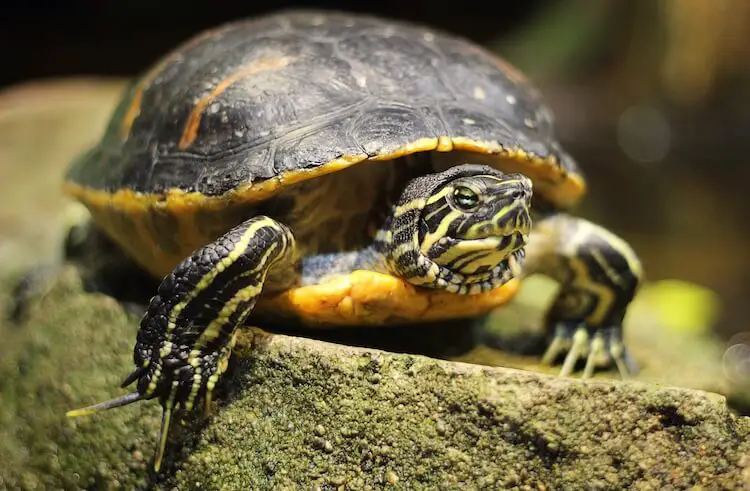
Yellow-bellied sliders are diurnal, just like humans. They are most active during the day. In the wild, they are often found in groups clustered around the best basking spots. However, these turtles can be territorial and prefer to live alone as pets.
As a pet, this species is very active and spends most of its time swimming, diving and basking.
When startled, sliders will quickly “slide” into the water to escape. Though more suited to swimming, these turtles are surprisingly quick on land and can sprint short distances.
If tank temperatures are warm enough, you will most often find your Yellow-bellied turtle in the water rather than on land. Sliders are great swimmers and often sleep underwater, but they still need access to land to survive.
Yellow-bellied sliders like to rest on logs and banks throughout the day to bask and raise their body temperature.
Your turtle will move in and out of the water to keep its internal temperature at a constant level.
The cooler your turtle is the slower its movements and activities will be. In the wild sliders hibernate during the cold winter months, but in captivity, where temperatures are constant, they are active year-round.
Handling
Yellow-bellied sliders are not the most affectionate pet. Holding them can cause stress, and a stressed turtle will not hesitate to bite any fingers it can reach. Their long, flexible necks give them a surprisingly long reach.
If held yellow-bellied sliders will normally pull their heads and arms into their shell.
With regular and gentle handling your slider may become more relaxed, but they do best if left alone. If you must pick up your turtle, grasp it firmly with two hands as if it were a hamburger.
Always wash your hands before and after handling turtles, and avoid letting small children hold them. Pet turtles are a significant cause of salmonella cases in the United States, which can be deadly to children and people with compromised immune systems.
Buying Guide

The sale of turtles with a shell length of fewer than four inches is illegal in the U.S.
Juvenile yellow-bellied sliders are commonly sold online and at reptile shows. Depending on the seller they can cost $30 to $80.
It is also easy to find adults for sale because of their long lifespan. It is not unheard of for people to sell 20-year-old turtles. Buying an adult is not only more responsible, but also gives you a greater chance of getting a healthy pet.
The most expensive part of owning a slider is the tank and its setup. A 100-gallon tank and accessories will cost over $300.
When looking to purchase a yellow-bellied slider, make sure you are buying a captive-bred turtle from a good breeder. Healthy turtles should be alert and try to escape if approached by a person.
Facts
| Quick Summary Table | |
|---|---|
| Common Name (s) | Yellow-bellied Slider, Pond Slider, Yellow-bellied Terrapin |
| Scientific Name | Trachemys scripta scripta |
| Family Name | Emydidae |
| Genus Name | Trachemys |
| Range | North and South Carolina, Georgia, Alabama, Mississippi, northern Florida |
| Adult Size | 5 to 12 inches in length 1.5 to 7 pounds |
| Lifespan | 20 to 40 years |
| Similar Species/Popular Alternatives | Red-Eared Slider, Painted Turtle, Box Turtle |
Summary
Yellow-bellied sliders make great pets. They are energetic, beautiful to look at and have many interesting behaviors. They also enjoy swimming and are very active during the day.
If you are interested in purchasing a yellow-bellied slider, expect to take home a lively, engaging pet that will remain active for over 20 years.
But, do not adopt one of these turtles without thought.
To meet their needs, they need a lot of space and clean water. This requires lots of equipment, such as an aquarium filter, pump, heater and 100-gallon tank. These attractive turtles also like variety in their diet and thrive on a mix of insects, fresh vegetables and pellet food.
Already have a yellow-bellied slider? Let us know your experience in the comments!

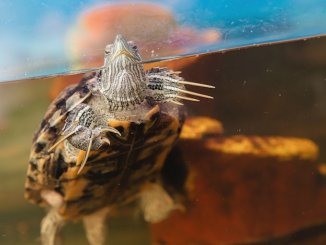
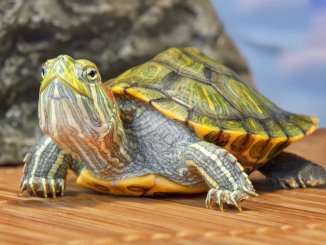
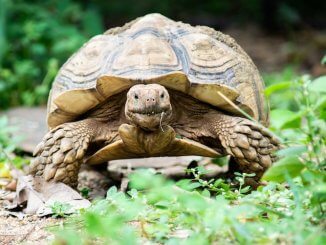

I just rescued a baby yellow bellied slider turtle and it is awesome! I gave it a big aquarium and some food. My turtle’s name is Walter.
I have two yellow bellies. They are 6years old. I have had them together since hatchlings. Recently, the bigger of the two has started chasing into corners and biting the smaller one. I believe the small one is male. It has a more convex back/thicker (from top of shell to under). Circumference smaller than the one I think is female with smoother flatter shell. I have a 75g tank. Heat lamp and UVB light and ZooMed external filter. I feed them pellets and leafy greens. Their first two years I fed them same plus live crickets and meal worms. What can I do to keep female (I think the bigger of two is female anyway) from injuring the male, besides separating them?
Hello! I have had 3 yellow bellies for 18 years now. Around year 11, mine also started to fight some. I tried to just put the 3 of them into a larger tank to give them more space, but unfortunately that did not solve the issue. After I returned home one day and the smallest turtle was missing the entire tip of his tail, I knew I had to separate them. These are pets that are better kept separate as they age as they are very territorial. Also, I believe you have the gender backwards. The females are taller/thicker, typically with short tails and shorter front nails while the males are flatter with longer tails and nails. Best of luck with your babies! I know I have loved having mine all these years!
I bought a baby yellow-bellied slider from a store yesterday…. For just $10! She’s healthy and active. Being a first-time reptile owner, your guide is sure to help me keep her alive and thriving. So thank you!
I have a beautiful yellow-bellied slider that I found almost a year and a half ago. I almost stepped on the little fella outside of my office one day. His name is Covid. He LOVES to eat superworms and would eat 24/7 I think. I have been working on setting him up with a more “natural” tank with driftwood and flat rocks. He’s is currently housed with several fish, which he doesn’t seem to bother, and with a crayfish. He has grown A LOT in the past year and a half.
I just got a yellow belied baby turtle.. named her nibbles. I love her… reading all I can as I know nothing about owning a turtle. Have had her for 2 weeks and Tajik her to our summer home in 2 more weeks where I will set her up well with aquarium and plants ect. As for now she is in a plastic tub with UVB light and Penny of water and a place to bask.. she is resting great and active.. after reading this I feel I need to get her some protein. She is eating turtle pellets now. She has a heater and a thermometer.. sure I’m cleaning tank too much but don’t have filter in her yet.. praying she stays good until I can get her up north for the summer
I found a slider on the road with a cracked shell. I took it home, gave it a name and a tank. The tank is mostly water while around 10% of it is filled with fine sand and pebbles. It is very shy and barely move when people are around. And doesn’t eat much. I gave it brocolli, fruits, tiny tadpoles and some water hyacinth. It’s been about a week.
If you’ve any advice. Whatsaap me 9862520778
It would be ideal if she had an area where to bask at around 85-95°F, and water deep enough to submerge himself. If you don’t plan to take her out the enclosure and into the sun often, you will need a UVB bulb too. She might also appreciate some feeder fish like guppies or minnows or land creatures like earthworms and slugs. She’ll need that protein to try and repair her shell. She is probably stressed from whatever happened to her, so give her time!
I have recently inherited/rescued an amazing 54 year old YBS! He has been in the same family(although rotated
amongst members/households)throughout his life. He has travelled out of state(left Alaska)for college(with one
of the family members)! Not sure if he received a degree. He is so smart and inquisitive I would not be surprised!
I am awaiting a complete written history(by family matriarch). I am so excited to learn all about his lengthy history
of travels and tribulations. I received him in far too small of living quarters. I have upgraded him to a 55 gallon
aquarium for the time being. He is visibly happy swimming and basking as he may never have. I look forward to
keeping him as healthy and happy as possible and enjoying his company for years to come.
I believe he may may be “therapy turtle”! His name is Columbus and he is my great new friend. I am so fortunate to
have him and I believe the feeling is mutual(he will come to me and rest his body on my hand while swimming in his
tank)! He loves classical music occasional treats of dried mealworms.
Wow! He has had one adventurous life. I understand your happiness and excitement about your new friend, YBSs can be incredibly interactive, affectionate, and communicative. You did good in upgrading his tank and if you want to know more ways to treat your slider consider placing in the enclosure plants, rocks and other features he might find in nature, floating food, and perhaps one day, another turtle friend!
We have 1 yellow and 3 red eared sliders. They all live in the same tank ever since we have had them. They’re not really aggressive. We have had the 2 from about 15 years ago and then a few more showed up year after year so now its down to the 4 we have left Shelly, harold, donnie and leo